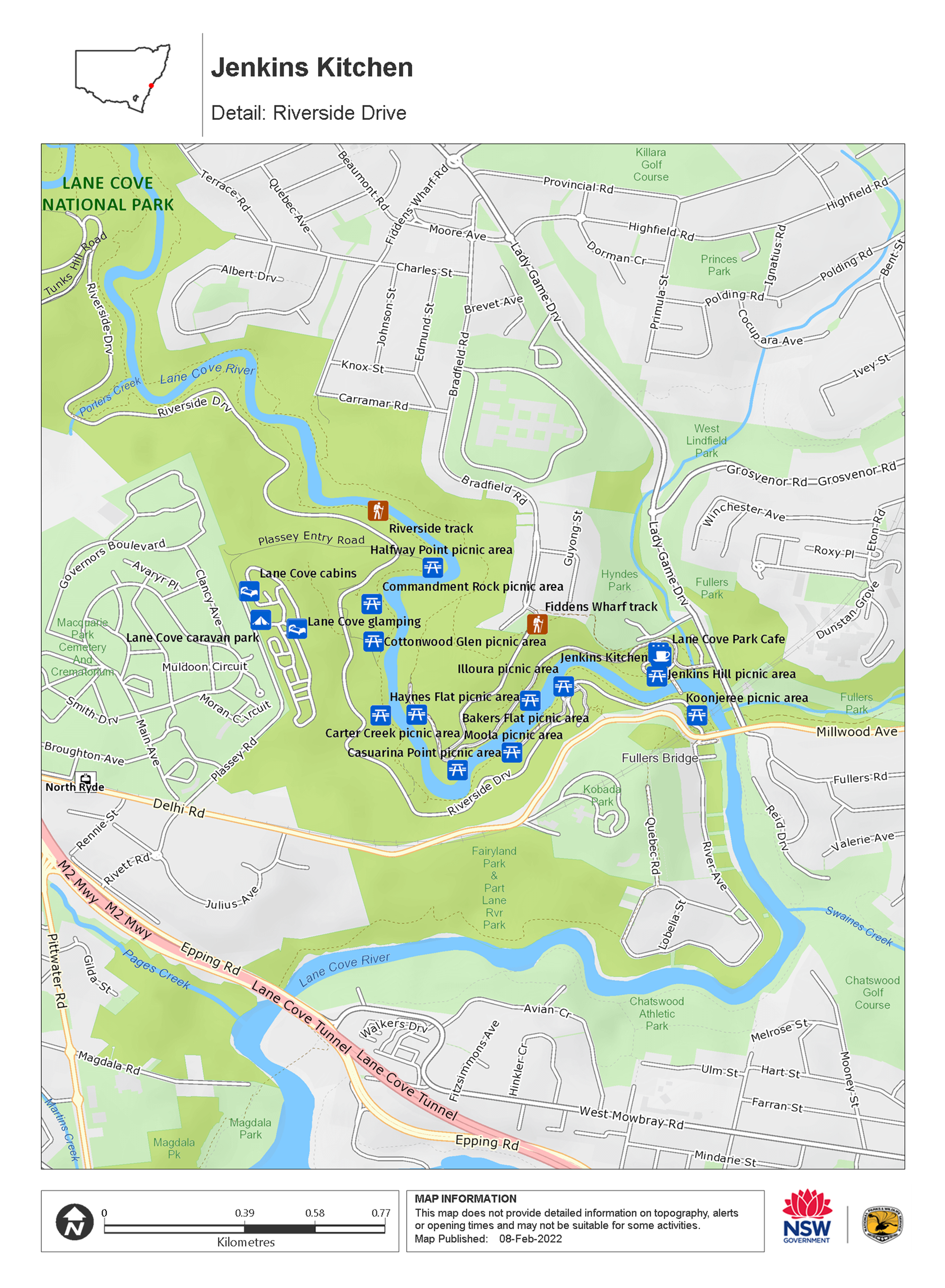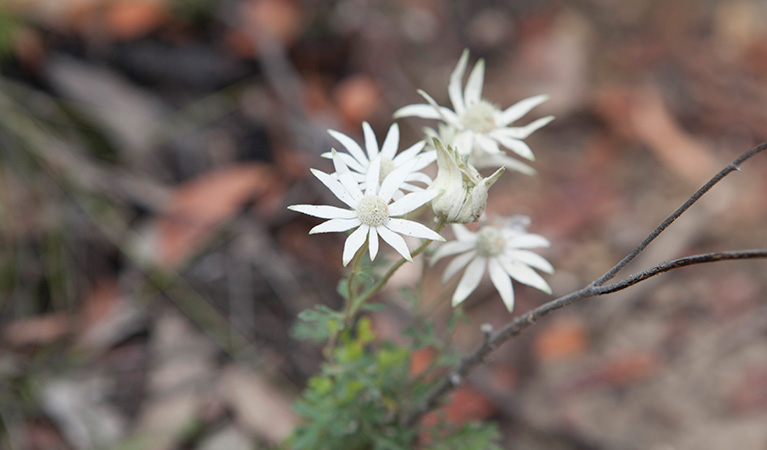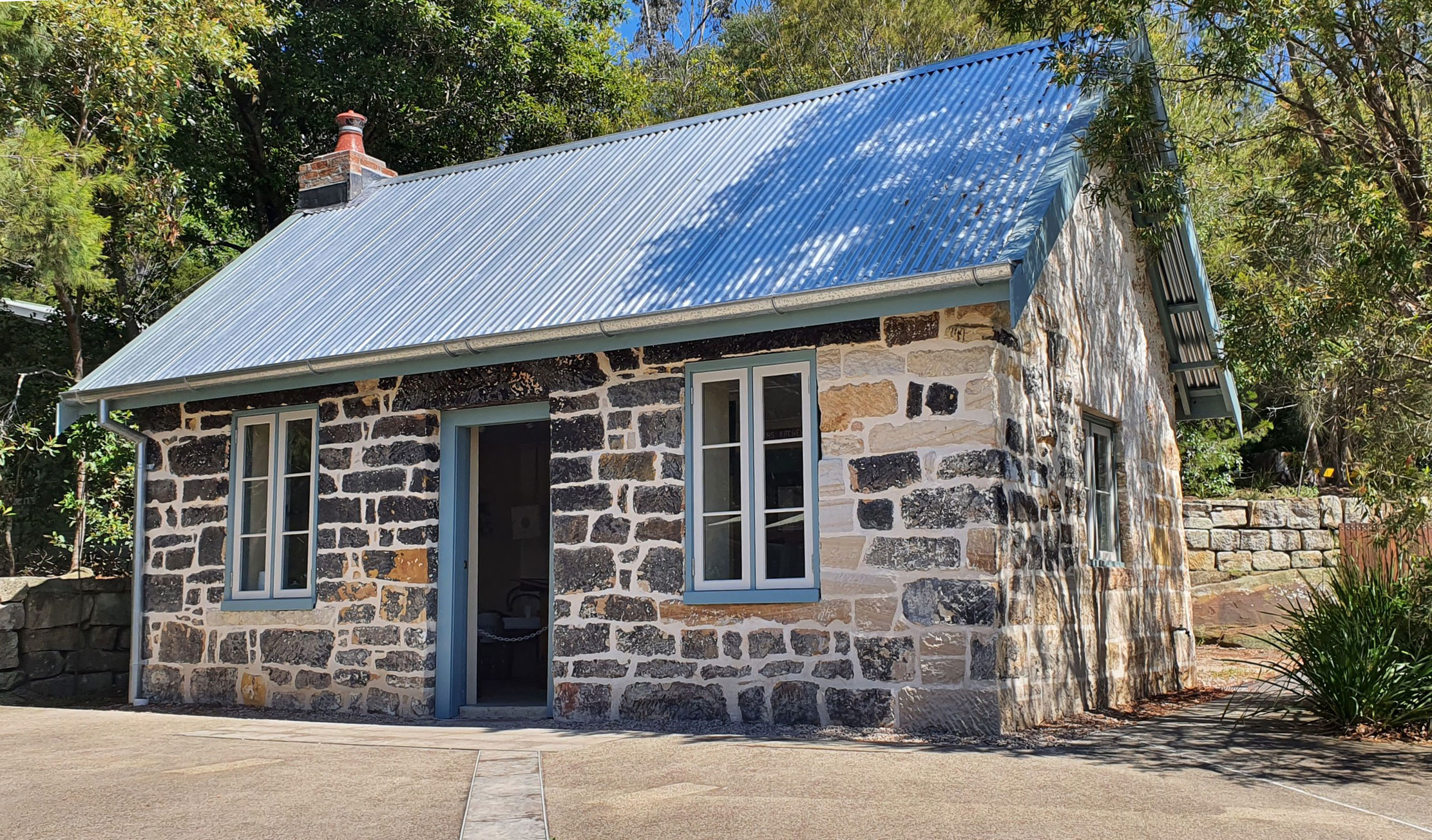Jenkins Kitchen
Lane Cove National Park
Overview
Jenkins Kitchen is a great way to discover local history in peaceful parkland, near Chatswood. Combine your visit to this heritage stone building with a walk, boat ride, or simply linger near the river and enjoy a tasty café snack.
- Type
- Historic buildings/places
- Accessibility
- Medium
- Grade
- Easy
- Entry fees
- Park entry fees apply
- Opening times
- Tuesday to Sunday, 10am to 4pm. Closed Monday.
- What to
bring - Hat, sunscreen
- Please note
- Visit the Lane Cove National Park office for more information and maps of the area.
Jenkins Kitchen offers a fascinating glimpse into colonial history. It was built in 1856 by Thomas and Maria Jenkins, who owned a great deal of property along Lane Cove River. Today the kitchen is all that remains after a 1942 fire burned Jenkins farmhouse.
Step inside to discover what a mid-19th century kitchen looks like. A fine example of sandstone architecture, the kitchen has a stone fireplace and antique lamps and furniture. Check out the video displays and learn about the plants and animals that call Lane Cove National Park home.
There are plenty of activities nearby to keep the family busy, happy and fed. Enjoy a tasty meal at Lane Cove National Park Café while the kids play in the covered playground. Or bring snacks for a riverside picnic at Jenkins Hill picnic area and watch kookaburras, lorikeets and butcher birds go about their business.
You can hire a boat to explore Lane Cove River or discover other homesteads and cottages along the Heritage walk. Ambitious bushwalkers can explore a section of the multi-day Great North walk.
Nearby
-

Jenkins Hill picnic area
Jenkins Hill picnic area in a popular picnic spot in Lane Cove National Park. Children can play at the playground while you relax on the grass in the shade.
-

Lane Cove National Park Cafe
At Lane Cove National Park Cafe you can grab a coffee, tasty breakfast or leisurely lunch while exploring Lane Cove National Park, near Chatswood. There's also a playground for the kids.
Map

Map legend

Local alerts
For the latest updates on fires, closures and other alerts in this area, see https://www.nationalparks.nsw.gov.au/things-to-do/historic-buildings-places/jenkins-kitchen/local-alerts
General enquiries
- National Parks Contact Centre
- 7am to 7pm daily
- 1300 072 757 (13000 PARKS) for the cost of a local call within Australia excluding mobiles
- parks.info@environment.nsw.gov.au
Park info
- in Lane Cove National Park in the Sydney and surrounds region
Lane Cove National Park is open 9am to 7pm during daylight savings (until 6pm at other times). The park may have to close at times due to poor weather or fire danger.
-
Park entry fees:
$8 per vehicle per day. Day passes are available from on-park pay machines that accept coins and credit cards, and you can also pay for your visit via the Park’nPay app.
Bus: $4.40 per adult, $2.20 per child (per day). Prior payment may be required, please phone the Lane Cove National Park Office for more information.
Group bookings:
Under the National Parks and Wildlife Regulation 2009, prior written approval is required for organised groups of 30 or more people planning to visit the park. Contact the park office prior to your visit.
Buy annual pass.
Visitor info
All the practical information you need to know about Jenkins Kitchen.
Getting there and parking
Jenkins Kitchen is 30m from Lane Cove National Park Café, just above the weir in Lane Cove National Park. The best entrance to use is the park entrance off Lady Game Drive. To get there from Sydney city centre:
- Turn right from Millwood Avenue into Lady Game Drive just before crossing the bridge.
- Take the first left into Max Allen Road on the northern side of the river.
Road quality
- Sealed roads
Vehicle access
- 2WD vehicles
Weather restrictions
- All weather
Parking
Parking is available in an asphalt carpark, just north of Jenkins Kitchen, including 1 accessible parking space.
By bike
Cyclists can use Max Allen Road, and store bikes at Lane Cove National Park Cafe.
By public transport
Lane Cove National Park is accessible from North Ryde station and by bus from Chatswood station.
Facilities
Ambulant flush toilets and picnic tables are available at Jenkins Hill picnic area, which you can reach along a 20m concrete footpath from Jenkins Kitchen.
Cafe/kiosk
Drinking water
Seats and resting points
There's a timber bench seat with backrest just south of Jenkins Kitchen at the end of Heritage walk.
Maps and downloads
Accessibility
Disability access level - medium
Jenkins Kitchen can be reached along step-free concrete and hard-packed ground pathways.
Once you reach the kitchen, there's a wide, paved area around the building. Inside, the kitchen is flat and step-free.
- You may need assistance to enter the building - there's a single door with a single step, and the doorway is too narrow to fit a wheelchair.
- There's a timber bench seat with a backrest south of the kitchen where you can rest
- There's 1 accessible parking space in the carpark
- There are ambulant toilets and picnic tables at Jenkins Hill picnic area, a 20m walk from the kitchen along a concrete path.
Permitted
Prohibited
Camp fires and solid fuel burners
Camping
Gathering firewood
Generators
Horses
Pets
Pets and domestic animals (other than certified assistance animals) are not permitted. Find out which regional parks allow dog walking and see the pets in parks policy for more information.
Smoking
NSW national parks are no smoking areas.
Learn more
Jenkins Kitchen is in Lane Cove National Park. Here are just some of the reasons why this park is special:
Native plants and animals

The landscape of Lane Cove National Park is remarkable given that it sits within a large urban environment. You'll see eucalypt forests, casuarina woodland and saltwater wetlands, each of which is home to a range of different plants, animals and birds. Echidnas are mainly nocturnal, but sometimes venture out during the day when the weather is mild you'll have to be quick and quiet to catch a glimpse though, the slightest noise will have them curling up into a ball for protection and camouflage. If you're walking along the river and you think you've spied something that looks a little unusual, it could very well be an eastern water dragon - look for its distinctive black stripes and crest of enlarged spiny scales along its body.
- Forest therapy walk in Lane Cove National Park Slow down and immerse yourself in nature on this peaceful guided forest therapy walk in Sydney’s Lane Cove National Park.
- Great North walk - Lane Cove National Park Passing through Lane Cove National Park, this multi-day hike offers stunning scenery across Sydney, the Hunter Valley and Newcastle. Tackle part of the track for an easy day walk.
Sydney’s backyard

Lane Cove National Park sits on the doorstep of Australia’s largest city, offering a wealth of opportunities for Sydneysiders and visitors to experience nature and spend time with family and friends. With opportunities for bushwalking and biking, kayaking and boating, picnicking and playing, you're guaranteed to want to visit again and again and it’s so close that you can. Did you know you can even go camping at Lane Cove National Park? For bush camping in an urban environment, head to Lane Cove River Tourist Park on the south western side of the park.
- Carter Creek picnic area Book Carter Creek picnic area for your next celebration. There are shaded picnic tables and gas barbecues. Plus it's right by the river.
- Pennant Hills West Pymble fire trail Ride the Pennant Hills to West Pymble fire trail for scenic views of Sydney and bushland. There's plenty of variety with technical parts and steep sections.
Connection to Country

Lane Cove National Park is part of the traditional lands of Aboriginal people whose Country extended from around Newcastle to Sydney Harbour. They lived primary by the water; fishing and hunting in the waters and hinterlands and harvesting food from surrounding bushland. The park protects a number of ancient Aboriginal sites today, some of which you may notice while exploring the park.
Plants and animals protected in this park
Animals
-

Australian brush turkey (Alectura lathami)
The Australian brush turkey, also known as bush or scrub turkey, can be found in rainforests along eastern NSW. With a striking red head, blue-black plumage and booming call, these distinctive Australian birds are easy to spot while bird watching in several NSW national parks.
-

Eastern water dragon (Intellagama lesueurii lesueurii)
The eastern water dragon is a subaquatic lizard found in healthy waterways along eastern NSW, from Nowra to halfway up the Cape York Pensinsula. It’s believed to be one of the oldest of Australian reptiles, remaining virtually unchanged for over 20 million years.
-

Kookaburra (Dacelo novaeguineae)
Of the 2 species of kookaburra found in Australia, the laughing kookaburra is the best-known and the largest of the native kingfishers. With its distinctive riotous call, the laughing kookaburra is commonly heard in open woodlands and forests throughout NSW national parks, making these ideal spots for bird watching.
-

Lace monitor (Varanus varius)
One of Australia’s largest lizards, the carnivorous tree-dwelling lace monitor, or tree goanna, can grow to 2m in length and is found in forests and coastal tablelands across eastern Australia. These Australian animals are typically dark blue in colour with whitish spots or blotches.
-

Short-beaked echidna (Tachyglossus aculeatus)
One of only 2 egg-laying mammals in the world, the short-beaked echidna is one of the most widespread of Australian native animals. Covered in spines, or quills, they’re equipped with a keen sense of smell and a tube-like snout which they use to break apart termite mounds in search of ants.
-

Superb fairy wren (Malurus cyaneus)
The striking blue and black plumage of the adult male superb fairy wren makes for colourful bird watching across south-eastern Australia. The sociable superb fairy wrens, or blue wrens, are Australian birds living in groups consisting of a dominant male, mouse-brown female ‘jenny wrens’ and several tawny-brown juveniles.
-

Swamp wallaby (Wallabia bicolor)
The swamp wallaby, also known as the black wallaby or black pademelon, lives in the dense understorey of rainforests, woodlands and dry sclerophyll forest along eastern Australia. This unique Australian macropod has a dark black-grey coat with a distinctive light-coloured cheek stripe.
Plants
-

Grass tree (Xanthorrea spp.)
An iconic part of the Australian landscape, the grass tree is widespread across eastern NSW. These Australian native plants have a thick fire-blackened trunk and long spiked leaves. They are found in heath and open forests across eastern NSW. The grass tree grows 1-5m in height and produces striking white-flowered spikes which grow up to 1m long.
-

Smooth-barked apple (Angophora costata)
Smooth-barked apple gums, also known as Sydney red gum or rusty gum trees, are Australian native plants found along the NSW coast, and in the Sydney basin and parts of Queensland. Growing to heights of 15-30m, the russet-coloured angophoras shed their bark in spring to reveal spectacular new salmon-coloured bark.
-

Old man banksia (Banksia serrata)
Hardy Australian native plants, old man banksias can be found along the coast, and in the dry sclerophyll forests and sandstone mountain ranges of NSW. With roughened bark and gnarled limbs, they produce a distinctive cylindrical yellow-green banksia flower which blossoms from summer to early autumn.
-

Flannel flower (Actinotus helianthi)
The delicate flannel flower is so named because of the soft woolly feel of the plant. Growing in the NSW south coast region, extending to Narrabri in the Central West and up to south-east Queensland, its white or pink flowers bloom all year long, with an extra burst of colour in the spring.
-

Scribbly gum (Eucalyptus haemastoma)
Easily identifiable Australian native plants, scribbly gum trees are found throughout NSW coastal plains and hills in the Sydney region. The most distinctive features of this eucalypt are the ‘scribbles’ made by moth larva as it tunnels between the layers of bark.
-

Wonga wonga vine (Pandorea pandorana)
The wonga wonga vine is a widespread vigorous climber usually found along eastern Australia. A variation of the plant occurs in the central desert, where it resembles a sprawling shrub. One of the more common Australian native plants, the wonga wonga vine produces bell-shaped white or yellow flowers in the spring, followed by a large oblong-shaped seed pod.

